Time Emits Calendar Research
Ancient Calendars of the Holy Bible
|
Mayan Calendar 20-year Katun Time Split with 105-day Lunar Side
and 105-day Solar Side shows how 210-days l/s separation time
divide for equal halves of 105-days each. God is "coming between"
daylight and darkness, or between lunar and solar sides of the
calendar. Analogy for 360-day road changes from 209-days in
19-years to 210-days per 20-years. Mayan practice of counting
20-year l/s cycles increments separate units.
Mayan_Calendar_Katun_20-year_Time_Split_Tool
http://youtu.be/QTKY0BlVBTM
Mayan Calendar Katun 20-year Time Split Tool
Slide9-10.mp4 7:49 19.5 Mb begins with Slide9pc50.png
Mayan Calendar Splitting of Time 0:15
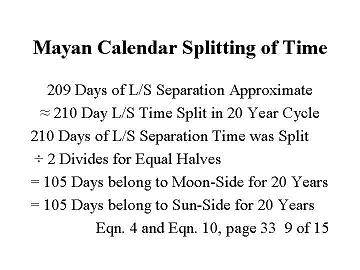 Previous
Ages_of_Adam videos explore the 19-year lunar/solar
cycle with associated 209-day lunar/solar separation time.
We started with the Jewish calendar, which explains ideas about God “coming between” daylight
and darkness. Judaism changes the day just after sundown.
Subordinate to a single God
without form or flesh, a duality exists regarding time. The
nighttime lunar-side of lunar/solar calendars has a feminine
nature, while the daylight solar-side aligns with masculine, sky
father concepts. Visible observations compound the same belief set
by lengthening lunar/solar reckoning. God is still “coming
between” lunar and solar sides of the calendar.
Previous
Ages_of_Adam videos explore the 19-year lunar/solar
cycle with associated 209-day lunar/solar separation time.
We started with the Jewish calendar, which explains ideas about God “coming between” daylight
and darkness. Judaism changes the day just after sundown.
Subordinate to a single God
without form or flesh, a duality exists regarding time. The
nighttime lunar-side of lunar/solar calendars has a feminine
nature, while the daylight solar-side aligns with masculine, sky
father concepts. Visible observations compound the same belief set
by lengthening lunar/solar reckoning. God is still “coming
between” lunar and solar sides of the calendar.
A 19-year lunar/solar cycle works great for one time
through. When you start the next 19-years, you need a different way
to record time. Otherwise, you are right back where you started.
Suppose you are riding in God's
car along the 360-day road about 2500 BCE. Car looks like
the Flintstones or something. The 360-day center line divides
a one-way road having two lanes. One lane is marked lunar and the
other lane is solar. At first, there are 209-days of distance
between lunar and solar sides. Women are holding signs
that say “19-years” by the lunar-side. Men
in contrast stand along the solar-side of the road and they
too hold signs that say “19-years.” You drive this road for
a long time and notice that every 19-year part looks the
same.
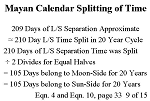
|
Get Mayan_Calendar_Katun_20-year_Time_Split_Tool
Video_&_Script Mayan Calendar
20-year Katun Time Split with 105-day Lunar Side and 105-day
Solar Side shows how 210-days l/s separation time divide for
equal halves of 105-days each. God is "coming between"
daylight and darkness, or between lunar and solar sides of
the calendar. Analogy for 360-day road changes from 209-days
in 19-years to 210-days per 20-years. Mayan practice of
counting 20-year l/s cycles increments separate units. Ministry_Affiliates
make 12.5% per sale.
Cart Item MCK20YTSVT
includes Mayan_Calendar_Katun_20-year_Time_Split_Tool.mp4
Video download 20 mb 7:49 and transcript PDF
336 kb from Paypal-Payloadz
eStore for Only $ 1.98
|

V-20 mb
T-337 kb
1.98
|
Whiteboard 360-Day Road Picture Slide9picb.png 0:15
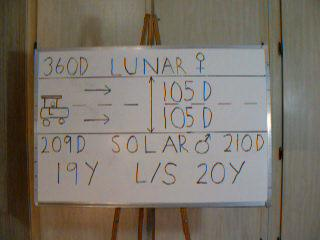
You finally cross this 20-year line, where the road
changes to 210-days of difference between lunar and solar
sides. The 20-year part has two lanes with 105-days each.
Men and women along the road now have signs that read "20-years."
Men improve their signs by adding numbers to count
20-year cycles. As you pass their signs, you know how many 20-year
lunar/solar cycles have elapsed. Signs change 20-year
units to show total distance.
210-Day Time Split for a 20-Year Cycle, See Figure
5 AoA p. 37
Slide_10a.mp4 12.6 mb 4:22 original with Slide10pc50b.png
0:15
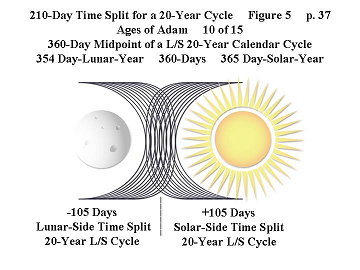 Mayans chose to add a 20th year unit, called a
Katun in popular terminology. The twentieth year offers the
next building block to time progression. The fundamental Mesoamerican
20-year lunar/solar cycle results in 210-days of
lunar/solar separation time. We then divide or time
split by two instead of intercalating 7-months (Eqn. 10, p.
33). You can follow equation 10 on p. 33. An ingenious calendar
develops by isolating 105-days of solar-side during the
next 20th, 365-day-solar-year. Repeating 105-days-solar-side
every year and especially for 20-year lunar/solar cycles
commits a major calendar tool. The remaining 260-days convert
to be the integral 260-day-sacred-year for all Mesoamerican
calendar systems. Notice I add hyphens and capital letters
in Ages_of_Adam to
clarify terms.
Mayans chose to add a 20th year unit, called a
Katun in popular terminology. The twentieth year offers the
next building block to time progression. The fundamental Mesoamerican
20-year lunar/solar cycle results in 210-days of
lunar/solar separation time. We then divide or time
split by two instead of intercalating 7-months (Eqn. 10, p.
33). You can follow equation 10 on p. 33. An ingenious calendar
develops by isolating 105-days of solar-side during the
next 20th, 365-day-solar-year. Repeating 105-days-solar-side
every year and especially for 20-year lunar/solar cycles
commits a major calendar tool. The remaining 260-days convert
to be the integral 260-day-sacred-year for all Mesoamerican
calendar systems. Notice I add hyphens and capital letters
in Ages_of_Adam to
clarify terms.
The classical Mayan calendar has several repeating cycles that
nest within larger cycles to become significant calendar tools.
Numerical matching of X-number of days with X-number of years
furthermore defines another calendar tool. A third calendar tool
is the time split, which simply divides time at some
predetermined point coincident with natural timekeeping. Basic
principles of Mayan calendar math extend our
interpretation of early Bible
history. Jewish, Mayan and Egyptian calendar nuances braid
together to connect with extremely remote genealogy in Ages_of_Adam.
Calendar tools are stepping-stones that render value to ages
listed in Genesis 5.
Whiteboard 105-Day-Lunar-Side/105-Day-Solar-Side Picture
Slide10pic.png
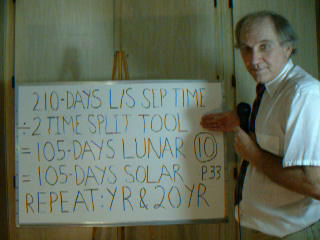 Mayan
religious culture employed a 260-day-Tzolken-sacred-year and a
360-day-Tun-civil-year. Five holidays add to complete one
365-day-solar-year. Every 365-day-solar-year reiterates the
solar-side time split tool for 105-days and 260-days remain.
Annual 260-day-Tzolken-sacred-year terms duplicate patterns
set by the last 20th-year of 20-year lunar/solar cycles.
Divinatory 260-day-Tzolken-sacred-years combine name and
day-number sequences to specify dates. Twenty named periods
multiply by 13-days each to make the 260-day-Tzolken-sacred-year.
Tzolken and Tun years work together like gears. See Ages_of_Adam pages 49-51 and
go to the next video for more information (Eqns. 14-18, p. 49).
Mayan
religious culture employed a 260-day-Tzolken-sacred-year and a
360-day-Tun-civil-year. Five holidays add to complete one
365-day-solar-year. Every 365-day-solar-year reiterates the
solar-side time split tool for 105-days and 260-days remain.
Annual 260-day-Tzolken-sacred-year terms duplicate patterns
set by the last 20th-year of 20-year lunar/solar cycles.
Divinatory 260-day-Tzolken-sacred-years combine name and
day-number sequences to specify dates. Twenty named periods
multiply by 13-days each to make the 260-day-Tzolken-sacred-year.
Tzolken and Tun years work together like gears. See Ages_of_Adam pages 49-51 and
go to the next video for more information (Eqns. 14-18, p. 49).
tags Mayan, calendar, cycle, Tzolken, Tzolkin, tool, Katun, Jewish,
Tun, civil, worship, documentary, video, transcript, time, split
Clark Nelson is webmaster for http://timeemits.com/Get_More_Time.htm,
author of Ages_of_Adam
and sequel, Holy_of_Holies.
Revised Copyright 2014
All Rights Reserved. URL http://timeemits.com/Scripts/Mayan_Calendar_Katun_20-year_Time_Split_Tool.html
 Previous
Ages_of_Adam videos explore the 19-year lunar/solar
cycle with associated 209-day lunar/solar separation time.
We started with the Jewish calendar, which explains ideas about God “coming between” daylight
and darkness. Judaism changes the day just after sundown.
Subordinate to a single God
without form or flesh, a duality exists regarding time. The
nighttime lunar-side of lunar/solar calendars has a feminine
nature, while the daylight solar-side aligns with masculine, sky
father concepts. Visible observations compound the same belief set
by lengthening lunar/solar reckoning. God is still “coming
between” lunar and solar sides of the calendar.
Previous
Ages_of_Adam videos explore the 19-year lunar/solar
cycle with associated 209-day lunar/solar separation time.
We started with the Jewish calendar, which explains ideas about God “coming between” daylight
and darkness. Judaism changes the day just after sundown.
Subordinate to a single God
without form or flesh, a duality exists regarding time. The
nighttime lunar-side of lunar/solar calendars has a feminine
nature, while the daylight solar-side aligns with masculine, sky
father concepts. Visible observations compound the same belief set
by lengthening lunar/solar reckoning. God is still “coming
between” lunar and solar sides of the calendar.


 Mayans chose to add a 20th year unit, called a
Katun in popular terminology. The twentieth year offers the
next building block to time progression. The fundamental Mesoamerican
20-year lunar/solar cycle results in 210-days of
lunar/solar separation time. We then divide or time
split by two instead of intercalating 7-months (Eqn. 10, p.
33). You can follow equation 10 on p. 33. An ingenious calendar
develops by isolating 105-days of solar-side during the
next 20th, 365-day-solar-year. Repeating 105-days-solar-side
every year and especially for 20-year lunar/solar cycles
commits a major calendar tool. The remaining 260-days convert
to be the integral 260-day-sacred-year for all Mesoamerican
calendar systems. Notice I add hyphens and capital letters
in
Mayans chose to add a 20th year unit, called a
Katun in popular terminology. The twentieth year offers the
next building block to time progression. The fundamental Mesoamerican
20-year lunar/solar cycle results in 210-days of
lunar/solar separation time. We then divide or time
split by two instead of intercalating 7-months (Eqn. 10, p.
33). You can follow equation 10 on p. 33. An ingenious calendar
develops by isolating 105-days of solar-side during the
next 20th, 365-day-solar-year. Repeating 105-days-solar-side
every year and especially for 20-year lunar/solar cycles
commits a major calendar tool. The remaining 260-days convert
to be the integral 260-day-sacred-year for all Mesoamerican
calendar systems. Notice I add hyphens and capital letters
in  Mayan
religious culture employed a 260-day-Tzolken-sacred-year and a
360-day-Tun-civil-year. Five holidays add to complete one
365-day-solar-year. Every 365-day-solar-year reiterates the
solar-side time split tool for 105-days and 260-days remain.
Annual 260-day-Tzolken-sacred-year terms duplicate patterns
set by the last 20th-year of 20-year lunar/solar cycles.
Divinatory 260-day-Tzolken-sacred-years combine name and
day-number sequences to specify dates. Twenty named periods
multiply by 13-days each to make the 260-day-Tzolken-sacred-year.
Tzolken and Tun years work together like gears. See
Mayan
religious culture employed a 260-day-Tzolken-sacred-year and a
360-day-Tun-civil-year. Five holidays add to complete one
365-day-solar-year. Every 365-day-solar-year reiterates the
solar-side time split tool for 105-days and 260-days remain.
Annual 260-day-Tzolken-sacred-year terms duplicate patterns
set by the last 20th-year of 20-year lunar/solar cycles.
Divinatory 260-day-Tzolken-sacred-years combine name and
day-number sequences to specify dates. Twenty named periods
multiply by 13-days each to make the 260-day-Tzolken-sacred-year.
Tzolken and Tun years work together like gears. See